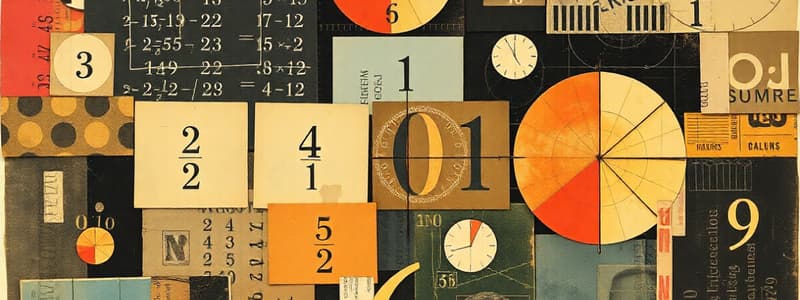Podcast
Questions and Answers
What is the correct order of operations in mathematics?
What is the correct order of operations in mathematics?
- Exponents, Parentheses, Multiplication, Division, Addition, Subtraction
- Parentheses, Exponents, Multiplication, Division, Addition, Subtraction (correct)
- Addition, Subtraction, Multiplication, Division, Parentheses, Exponents
- Multiplication, Division, Addition, Subtraction, Parentheses, Exponents
Rounding a number always makes it more accurate.
Rounding a number always makes it more accurate.
False (B)
What is the decimal equivalent of $\frac{3}{4}$?
What is the decimal equivalent of $\frac{3}{4}$?
0.75
$\frac{1}{2}$ is equivalent to what percentage? __________%
$\frac{1}{2}$ is equivalent to what percentage? __________%
Match the following terms with their definitions:
Match the following terms with their definitions:
Which of the following is an example of a proportional problem?
Which of the following is an example of a proportional problem?
When solving for an unknown in an equation, the goal is to isolate the variable on one side of the equation.
When solving for an unknown in an equation, the goal is to isolate the variable on one side of the equation.
What is the average of the numbers 2, 4, 6, and 8?
What is the average of the numbers 2, 4, 6, and 8?
In the formula $A = \pi r^2$, '$\pi$' represents ________.
In the formula $A = \pi r^2$, '$\pi$' represents ________.
Match the type of graph with the data it is best suited to represent:
Match the type of graph with the data it is best suited to represent:
Which of the following correctly converts 0.65 to a percentage?
Which of the following correctly converts 0.65 to a percentage?
Simplifying an expression changes its value.
Simplifying an expression changes its value.
What is 25% of 80?
What is 25% of 80?
In the equation $y = mx + b$, 'm' represents the ________ of the line.
In the equation $y = mx + b$, 'm' represents the ________ of the line.
Match the following metric prefixes with their corresponding powers of 10:
Match the following metric prefixes with their corresponding powers of 10:
What is the value of $x$ in the equation $2x + 5 = 15$?
What is the value of $x$ in the equation $2x + 5 = 15$?
A pie chart is best used to show trends over time.
A pie chart is best used to show trends over time.
What is the area of a rectangle with a length of 10 units and a width of 5 units?
What is the area of a rectangle with a length of 10 units and a width of 5 units?
Two lines are perpendicular if the product of their slopes is ________.
Two lines are perpendicular if the product of their slopes is ________.
Match each operation with its inverse operation:
Match each operation with its inverse operation:
Flashcards
Basic Arithmetic Operations
Basic Arithmetic Operations
Addition, subtraction, multiplication, and division applied to whole numbers, decimals, and fractions.
Order of Operations
Order of Operations
Simplifying expressions by following the correct sequence of operations.
Simplification of Fractions
Simplification of Fractions
Reducing a fraction to its simplest form by dividing both numerator and denominator by their greatest common divisor.
Rounding Numbers
Rounding Numbers
Signup and view all the flashcards
Averaging Numbers
Averaging Numbers
Signup and view all the flashcards
Fraction to Decimal
Fraction to Decimal
Signup and view all the flashcards
Decimal to Fraction
Decimal to Fraction
Signup and view all the flashcards
Decimal to Percentage
Decimal to Percentage
Signup and view all the flashcards
Ordering Numbers
Ordering Numbers
Signup and view all the flashcards
Calculating Percentages
Calculating Percentages
Signup and view all the flashcards
Converting Measurements
Converting Measurements
Signup and view all the flashcards
Solving for Unknowns
Solving for Unknowns
Signup and view all the flashcards
Formulaic Problems
Formulaic Problems
Signup and view all the flashcards
Interpreting Visual Data
Interpreting Visual Data
Signup and view all the flashcards
Proportionality
Proportionality
Signup and view all the flashcards
Study Notes
- Covers basic arithmetic operations with whole numbers, decimals, and fractions.
- Includes order of operations and simplification.
- Addresses manipulating numbers through rounding.
- Covers averaging and converting between fractions, decimals, and percentages.
- Describes ordering numbers.
- Includes practical applications like calculating percentages.
- Includes coverting measurements and solving for unknowns.
- Mentions tackling proportional and formulaic problems.
- Focuses on interpreting visual data presented in graphs, charts, and tables.
Studying That Suits You
Use AI to generate personalized quizzes and flashcards to suit your learning preferences.




